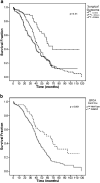Outcomes of primary surgical cytoreduction in patients with BRCA-associated high-grade serous ovarian carcinoma
- PMID: 22579790
- PMCID: PMC3909698
- DOI: 10.1016/j.ygyno.2012.05.001
Outcomes of primary surgical cytoreduction in patients with BRCA-associated high-grade serous ovarian carcinoma
Abstract
Objective: BRCA-associated and sporadic ovarian cancers have different pathologic and clinical features. Our goal was to determine if BRCA mutation status is an independent predictor of residual tumor volume following primary surgical cytoreduction.
Methods: We conducted a retrospective analysis of patients with FIGO stage IIIC-IV high-grade serous ovarian cancer classified for the presence or absence of germline BRCA mutations. The primary outcome was tumor-debulking status categorized as complete gross resection (0mm), optimal but visible disease (1-10 mm), or suboptimal debulking (>10 mm) following primary surgical cytoreduction. Overall survival by residual tumor size and BRCA status was also assessed as a secondary endpoint.
Results: Data from 367 patients (69 BRCA mutated, 298 BRCA wild-type) were analyzed. Rate of optimal tumor debulking (0-10 mm) in BRCA wild-type and BRCA-mutated patients were 70.1% and 84.1%, respectively (P=0.02). On univariate analysis, increasing age (10-year OR, 1.33; 95% CI, 1.07-1.65; P=0.01) and wild-type BRCA status (OR, 0.47; 95% CI, 0.23-0.94, P=0.03) were both significantly associated with suboptimal surgical outcome. On multivariate analysis, BRCA mutation status was no longer associated with residual tumor volume (OR, 0.63; 95% CI, 0.31-1.29; P=0.21) while age remained a borderline significant predictor (10-year OR, 1.25; 95% CI, 1.01-1.56; P=0.05). Both smaller residual tumor volume and mutant BRCA status were significantly associated with improved overall survival.
Conclusion: BRCA mutation status is not associated with the rate of optimal tumor debulking at primary surgery after accounting for differences in patient age. Improved survival of BRCA carriers is unlikely the result of better surgical outcomes but instead intrinsic tumor biology.
Copyright © 2012 Elsevier Inc. All rights reserved.
Figures
References
-
- Siegel R, Ward E, Brawley O, Jemal A. Cancer statistics, 2011: the impact of eliminating socioeconomic and racial disparities on premature cancer deaths. CA Cancer J Clin. 2011;61:212–236. - PubMed
-
- du Bois A, Reuss A, Pujade-Lauraine E, Harter P, Ray-Coquard I, Pfisterer J. Role of Surgical Outcome as Prognostic Factor in Advanced Epithelial Ovarian Cancer: A Combined Exploratory Analysis of 3 Prospectively Randomized Phase 3 Multicenter Trials By the Arbeitsgemeinschaft Gynaekologische Onkologie Studiengruppe Ovarialkarzinom (AGO-OVAR) and the Groupe d'Investigateurs Nationaux Pour les Etudes des Cancers de l'Ovaire (GINECO). Cancer. 2009;115:1234–1244. - PubMed
-
- Winter WE, Maxwell GL, Tian CQ, et al. Tumor residual after surgical cytoreduction in prediction of clinical outcome in stage IV epithelial ovarian cancer: A gynecologic oncology group study. Journal of Clinical Oncology. 2008;26:83–89. - PubMed
-
- Winter WE, 3rd, Maxwell GL, Tian C, et al. Prognostic factors for stage III epithelial ovarian cancer: a Gynecologic Oncology Group Study. J Clin Oncol. 2007;25:3621–3627. - PubMed
-
- Bristow RE, Tomacruz RS, Armstrong DK, Trimble EL, Montz FJ. Survival effect of maximal cytoreductive surgery for advanced ovarian carcinoma during the platinum era: A meta-analysis. Journal of Clinical Oncology. 2002;20:1248–1259. - PubMed
Publication types
MeSH terms
Grants and funding
LinkOut - more resources
Full Text Sources
Medical


